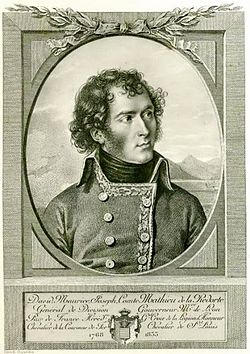David-Maurice-Joseph Mathieu de La Redorte | |
|---|---|
 General of Division David-Maurice-Joseph Mathieu de La Redorte | |
| Born | 20 February 1768 |
| Died | 1 March 1833 (aged 65) Paris, France |
| Allegiance | |
| Branch | French Army |
| Years of service | 1783–1830 |
| Rank | General of Division |
| Battles / wars | |
| Awards | Légion d'Honneur, 1804 Order of the Iron Crown, 1807 Order of Saint Louis, 1814 |
| Other work | Count of the Empire, 1810 Peer of France, 1819 |
David-Maurice-Joseph Mathieu de Saint-Maurice de La Redorte or Maurice Mathieu (French pronunciation: [davidmɔʁisʒozɛfmatjødəsɛ̃mɔʁisdəlaʁədɔʁt] ; 20 February 1768 – 1 March 1833) was a French general during the Napoleonic Wars.